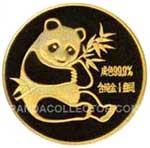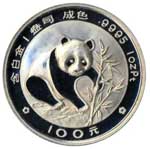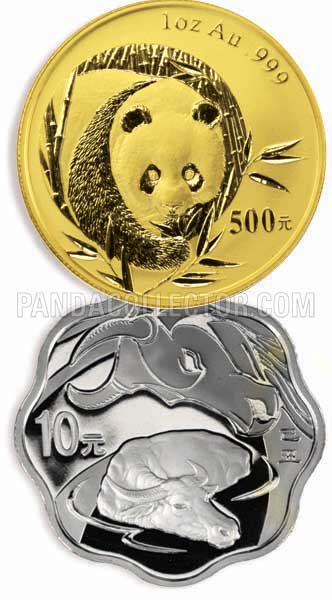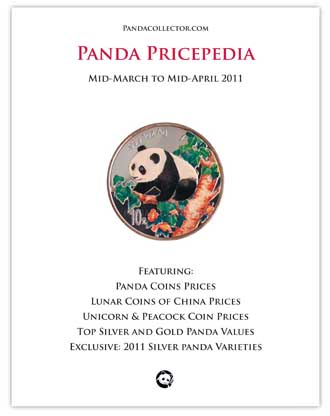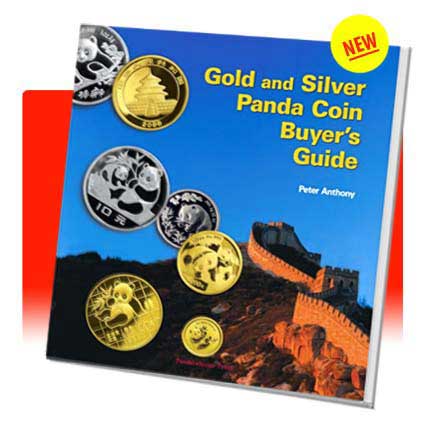 •••
••• ••
••  _••
_••
Why Buy a Panda?
Investors have many choices among the world’s gold bullion coins: U.S. Eagles and Buffaloes, Canadian Maple Leafs, South African Krugerrands, Austrian Symphonies, Australian Kangaroos, Mexican Pesos…and Chinese Pandas. Why choose one over another—a bullion coin is a bullion coin is bullion coin—all are gold; all sell for a small premium over their melt value.
In contrast, coins for which a combination of demand and scarcity causes the value to significantly exceed intrinsic, or melt, value are called “numismatic.” It is interesting that many older numismatic coins began their existence as common, circulating coinage. They became recognized as collectible when someone realized that they had become scarce for some reason; perhaps because few were minted originally or, perhaps, because few had survived over the years.
So, generally speaking, numismatic coins are distinguished by being in short supply relative to collector demand. Bullion coins, many of which are recent issues, are minted in large quantities and have their value defined by their metal content. It doesn’t often happen that coins cross over from one category to the other.
"...anyone who tries to find the entire run of dates will soon discover that some years are surprisingly hard to locate."
In the past, this usually occurred when attrition turned a formerly common coin into a rare coin. Prime examples of this are various dates of the American Silver Dollar, which was originally issued in huge quantities to help soak up the silver that poured out of Nevada’s Comstock Lode. Years later hundreds of millions of silver dollars were deemed surplus and sent back to the melting pot. The intriguing element of this story is that the coins weren’t melted in even proportion to the numbers originally minted. There was an element of chance to which dates were reclaimed. This caused some varieties to be almost entirely consumed, leaving very few specimens for collectors—but no one knew which ones. It took collectors many years to accurately identify which mintages had become scarce, or rare. Eventually researchers turned to tracking how many times a date/mint mark would appear at auction to determine its survival rate.
So what does this have to do with modern gold bullion coins? They were struck, recorded and sold to the public—you can easily check how many were minted. I believe, though, that there is at least one numismatic mystery lurking in this story—the Chinese Pandas.
Among the series of modern bullion coins the Giant Panda Series from China—available in gold and silver and also occasionally in platinum and palladium—stands out for using a new Panda image each year (with one exception). Because each year has a different design, many people try to collect a complete date set. The gold Pandas were first introduced in 1982, and the debut issue immediately soared in value as the Chinese Mint underestimated the demand for the coins. According to the Mint, only about 15,000 one ounce and 13,000 half ounce coins were struck the first year. The 1982’s remain in great demand and often sell for 3-5 times their bullion content.
While 1982 is a special case, what about subsequent years? Surely the Chinese Mint didn’t make the mistake of under-producing these coins again. Let’s take a look at some official mintage figures. The gold Panda coins are produced in sizes ranging from a giant 12 troy ouncer size down to tiny 1/20 ounce pieces.
The numbers show 1982 with the lowest mintage and 1983-84 following close behind. The mid-nineties also have a stretch of low production. Among the other dates, nothing looks like it should be particularly hard to find. This “official” list has apparently had a great influence on the market for Pandas, with the scarcer dates commanding premiums from date collectors. By the way, none of these numbers looks very large compared to, say, the 1.5 million 1999 American Eagles struck, or the 6 million Krugerrands made in 1978.
Year |
1 oz. Original Published Mintage |
1 oz. Revised (2007) Mintage |
1/2 oz. Original Published Mintage |
1/2 oz. Revised (2007) Mintage |
|---|---|---|---|---|
1982 |
15,815 | 13,532 | 13,300 | 13,391 |
1983 |
22,470 | 25,363 | 23,200 | 28,596 |
1984 |
23,330 | 25,183 | 16,900 | 20,057 |
1985 |
164,190 | 55,539 | 76,000 | 62,675 |
1986 |
127,000 | 107,132 | 60,290 | 48,618 |
1987 |
131,579 | 156,178 | 94,789 | 97,076 |
| 1988 | 167,193 | 289,055 | 103,557 | 220,443 |
| 1989 | 74,000 | 115,187 | 49,000 | 120,588 |
1990 |
45,561 | 53,898 | 35,066 | 35,091 |
1991 |
100,000 | 36,367 | NA | 32,717 |
1992 |
48,988 | 41,120 | NA | 26,495 |
1993 |
35,000 | 40,449 | NA | 31,254 |
1994 |
35,000 | 24,438 | NA | 16,788 |
1995 |
35,000 | 17,412 | 17,000 | 11,749 |
1996 |
35,000 | 22,009 | NA | 13,849 |
1997 |
125,000 | 30,457 | NA | 15,483 |
1998 |
125,000 | 20,507 | NA | 4,168 |
1999 |
125,000 | 32,439 | NA | 12,482 |
2000 |
NA | 29,011 | NA | 20,811 |
2001 |
150,000 | 41,411 | 100,000 | 33,215 |
2002 |
120,000 | 28,345 | 75,000 | 28,514 |
2003 |
120,000 | 36,300 | 75,000 | 25,000 |
2004 |
120,000 | 55,000 | 75,000 | 42,000 |
| 2005 | 150,000 | 50,300 | 60,000 |
35,410 |
While the mintage list would seem to answer the question of how many Pandas are extant, anyone who tries to find the entire run of dates will soon discover that some years are surprisingly hard to locate. So it was interesting when, in February of 2007, the Chinese Mint released a new list that claims to carry the actual mintages of coins produced, rather than the intended mintages.
If you compare the original published list and the revised list it is clear there are some serious discrepancies in the amounts claimed for each year. In particular, the second list shows huge mintages for 1988 and 1989 and much smaller mintages for 1991 and 1994 through 2005. It also looks like, in the second list, that 2003-2004 may be estimates as the numbers appear to be rounded off.
One might assume that the newer list settles any questions of how scarce the different dates are. As often happens with assumptions, one would (IMO) be wrong. Back in 2005 I became curious about how many of these Pandas were actually available. I thought about how scarcity had been determined in older coins by examining auction records to find the frequency that a date appeared for sale. This strategy, though, seemed like a non-starter with modern “bullion” coins because they seldom appear in the catalogs of numismatic auction houses. Presumably this is because the commission charge in a numismatic auction (around 20%) is inappropriate for the trading of “bullion” coins.
The 21st century, though, has provided us with a different and very public auction venue: eBay. At eBay the auction commissions are low enough to host a thriving community of buyers and sellers of coins; both numismatic and bullion. For a modest fee the seller gains a worldwide audience, while buyers can peruse offerings from across the globe. In this open environment enough coins get bought and sold that we may find some clues to their relative abundance.
So I decided to see if eBay could answer some of my questions. For the last 5 years I have attempted to log each and every one ounce and smaller gold Panda coin that has been sold on eBay. This includes eBay Europe and to a lesser degree Asia. I have recorded coin dates, conditions, auction numbers, prices realized and more. There are now many tens of thousands of records in the database. The most important conclusion I have come to is that many of the dates generally believed to be common are, in fact, uncommon. This adds an interesting facet to bullion coin buying—the potential for buying an unrecognized collector (numismatic) coin.
For those interested in the rarities of specific dates and varieties, the details of these studies are included in my new book, The Gold and Silver Panda Coin Buyer's Guide.
Add to this some of the other reasons for choosing Pandas like:
- The attractiveness and artistry of the coins themselves
- Being a product of the world’s fastest growing major economy
- Attractive to a potentially vast group of collectors
- Vast expatriate group of ethnic Chinese who are also a natural market
- The coins are real money—pure gold and silver
- Relatively small mintages
- Attrition of coins to mishandling and melting
- The continued global debasement of paper currencies
All these reasons and more make Pandas one of the most interesting forms of bullion coins one can buy. They are an intriguing way to protect against monetary debasement, possibly participate in Chinese economic growth and, for those so-inclined, develop an enjoyable and profitable hobby.
Happy collecting.
~PA~


